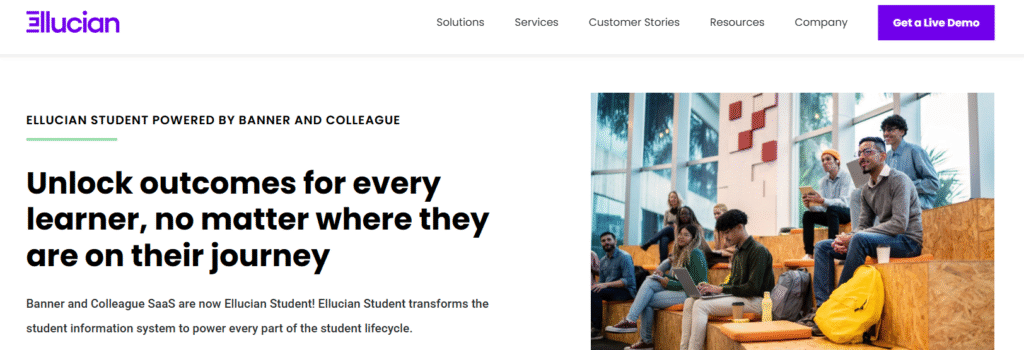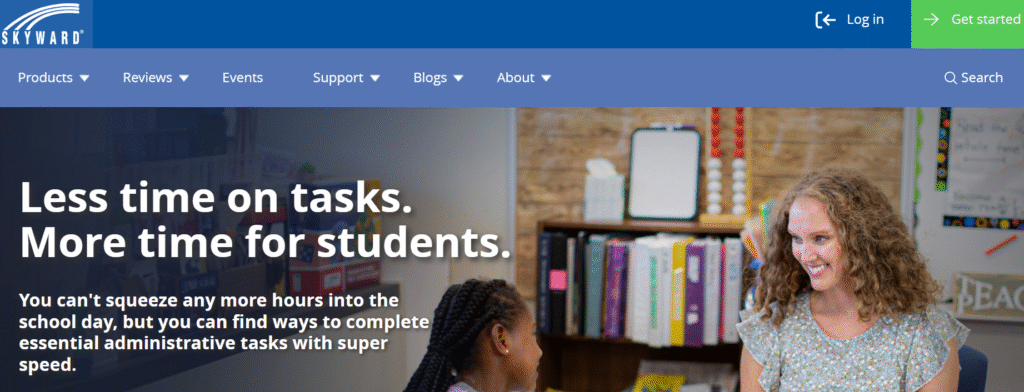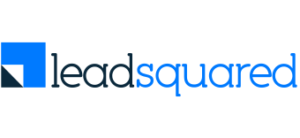On September 30, 2025, Anthology Inc., whose assets and liabilities totaled between $1 billion and $10 billion, filed for Chapter 11 bankruptcy protection in the United States Bankruptcy Court for the Southern District of Texas. Burdened by $1.8B debt, falling sales, price-driven customer churn, and an $80M income drop post-Blackboard merger, Anthology hit a breaking point. Significant parts of the company’s operations are being sold off. (Source)

Against this backdrop, if you’re looking for Anthology competitors, read on for some useful tips.
Understanding where you stand: The Anthology ecosystem explained
If you’re reading this, you’re likely in one of two situations:
Scenario 1: You use Anthology SIS with a third-party CRM (LeadSquared, Salesforce, HubSpot, etc.)
Your immediate concern: SIS stability and continuity.
What’s happening: Your SIS (Anthology Student) is being sold off, and this acquisition introduces:
- Potential integration disruptions with your existing CRM.
- Uncertainty around pricing and contract terms.
- Platform consolidation decisions by the new owner.
- Timeline: 3-6 months of uncertainty until the sale closes.
Your advantage: You’ve already separated your CRM from your SIS. This means you have operational flexibility and won’t face the more complex challenges outlined in Scenario 2.
Scenario 2: You’re all-in on Anthology (SIS + CRM Suite)
Your setup likely includes:
- Anthology Student (SIS/ERP) – Being sold.
- Anthology Encompass, Reach, Engage, Advance (CRM/Lifecycle Engagement) – Being sold.
- Student Success tools – Being sold.
- Blackboard LMS – Staying with reorganized Anthology.
With Anthology’s technology ecosystem now being divided and sold to different companies, many institutions are navigating a period of uncertainty. For those that depended on a single provider, it’s a reminder of how valuable it is to have both stability and flexibility built into their technology strategy — so they can adapt with confidence when change inevitably comes.
What this means operationally:
- Fragmented vendor relationships: You’ll now negotiate with separate companies instead of one.
- Integration nightmares: Systems built to work together will now require new connectors between separate companies.
- Different product roadmaps: Each buyer will have different strategic priorities.
- Pricing uncertainty: Multiple vendors = multiple renewal negotiations, often with price increases.
- Data migration pressure: If one piece fails, you may need emergency migrations.
Why this bankruptcy proves the danger of all-in-one systems
The Anthology bankruptcy isn’t just a business failure – it’s a cautionary tale about vendor dependency.
When institutions chose the Anthology ecosystem, they were drawn to the promise of seamless integration and unified data — a vision that’s appealing to all of us. But when fundamentally different purposes, like CRM and SIS, are forced into a single stack, the risks of vendor dependence become clearer. The real opportunity lies in building systems that integrate where it truly adds value, while still giving institutions the flexibility and resilience to adapt when circumstances change.
The hidden costs of “seamless” integration:
- The case for CRM separation: A smarter architecture
- Vendor lock-in: Switching costs are astronomical when everything is interconnected.
- Limited negotiating power: When one vendor controls your entire stack, you have little leverage.
- Single point of failure: One company’s bankruptcy affects your entire operations.
- Forced upgrades: Ecosystem updates require coordinated changes across all products.
The case for CRM separation: A smarter architecture
Here’s the reality: Your CRM and SIS serve fundamentally different purposes and should be treated as separate systems.
Why your CRM should be separate
1. Different lifecycles and upgrade cycles
SIS: Core infrastructure that changes slowly (5-10 year cycles).
CRM: Front-end engagement tool that needs frequent updates to match student expectations (1-2 year cycles).
Tying these together forces you to upgrade everything together or accept that your CRM lags behind modern engagement standards.
2. Vendor specialization matters
SIS Vendors (Ellucian, Anthology Student, Jenzabar): Focus on compliance, records management, financial aid, degree audits.
CRM Vendors (LeadSquared, Salesforce, Slate): Focus on application management, marketing automation, lead nurturing, communication workflows, conversion optimization, and other parts of the admissions lifecycle.
A CRM that’s bolted onto an SIS will never be as sophisticated as a purpose-built enrollment CRM.
3. Operational flexibility
When your CRM is separate:
- Marketing can iterate on campaigns without IT dependencies.
- Admissions can test new workflows without affecting student records.
- You can switch CRM providers without touching your SIS.
- You can add new communication channels (WhatsApp, SMS, chatbots) independently.
4. Financial protection
If one vendor fails, experiences price increases, or gets acquired:
- Your core student records remain stable (SIS).
- Your enrollment operations continue uninterrupted (CRM).
- You can negotiate from a position of strength.
Why LeadSquared is your go-to solution among Anthology competitors
LeadSquared’s Higher Education CRM is designed with the real challenges of colleges, training institutes, career schools, and universities in mind. Whether it’s keeping up with inquiries, staying on top of follow-ups, or guiding students from their first touchpoint to enrollment, it helps admissions and marketing teams stay organized and efficient. With powerful automation, easy-to-understand insights, and tools that play well with your existing systems, LeadSquared makes it easier to connect with students—and helps you hit your enrollment goals without the usual stress.

- Marketing automation that actually works: Instead of the basic, old-school emails your SIS might send, LeadSquared lets you build actual marketing campaigns. Automated sequences based on student behavior, personalized messaging by program type, follow-up campaigns for dormant leads. And you don’t need a computer science degree to set it up.
- It catches leads before they disappear: Maybe a prospect filled out a form on Saturday night, and without the right system, you wouldn’t see it until Tuesday. Or a lead came in through social media and slipped through the cracks. With LeadSquared, that doesn’t happen—you capture every lead instantly and route it to the right person. You can set up workflows that handle everything from lead assignment to follow-ups, all triggered by real-time actions—not rigid, outdated templates.
- Lead nurturing that doesn’t feel robotic: Whether a prospect is ready to apply or just browsing, LeadSquared keeps the conversation going. Timely check-ins, personalized content, and behavior-based nudges make sure no one falls through the cracks—or forgets you exist.
- Analytics that actually help: Your current system probably gives you reports about enrolled students. Great. But what about the 80% of prospects who didn’t enroll? Where did they drop off? Which recruitment events are working? Which marketing channels are worth the investment? That’s the stuff admissions teams actually need to know.
Positive reviews:
- G2: 5 out of 5 stars— “It saves time, reduces manual work, and keeps everything updated in real time. I can easily track lead status, assign tasks, and get reminders.”
- Case Study— “We recognized the importance of having the right technology and processes in place as we grow, and LeadSquared came recommended. The system is so easy to learn and allows our admissions team to focus on supporting the student experience.”
Thinking About A Complete System Replacement?
Sometimes the SIS isn’t the solution – it’s simply doing what it was built to do, but it can’t do it all. If you’re at that point, here are some other alternatives that may work for you:
PowerSchool – the user-friendly option

PowerSchool is trying really hard to break into higher ed after dominating K-12. In some ways, they’re succeeding. Their interface and their mobile apps are actually decent.
Positive review:
G2: 4 out of 5 stars— “Vast selection of integrations. Relatively seamless integration with Active Directory and Google Admin. Intuitive interface for end-users.
But you can tell it wasn’t originally built for colleges. The financial aid section is basic, and if you’ve got complex programs or unusual requirements, you might find yourself doing workarounds constantly.
If you are a small community college, say in Texas, that mostly does workforce development programs—simple structure, straightforward needs—it works fine. But we wouldn’t suggest it if you are a university with graduate programs and research requirements.
Ellucian Banner – the nuclear option

Ellucian Banner is like the Swiss Army knife of student information systems – it can do absolutely everything, but using it feels like performing surgery with a chainsaw.
If you’re a large university with a dedicated IT team that has a lot of patience, Banner can be incredibly powerful. The reporting capabilities are good, and there’s basically no student information task it can’t handle.
Positive review:
- G2: 4 out of 5 stars— “..helps us to track communication and the admissions process with each student we work with at all stages of the funnel.”
The problem? Implementation takes a long time. You may start a project and still be tweaking configurations years later. The learning curve is brutal, and the user interfaces look like they were designed by engineers for other engineers (which they probably were).
Ellucian Colleague is often positioned as the “Banner” system built for smaller institutions, but it still carries much of Banner’s complexity with it.
Already have Ellucian and looking for alternatives? Read this: Top 10 Ellucian Alternatives For 2025
Classter – the experiment
Classter is one of the newer platforms trying to combine SIS, LMS, and student management in one package. The appeal is obvious – one system to learn, one vendor to deal with, fewer integration headaches. But as Anthology’s situation shows, when too much rests on the fortunes of one provider, that convenience can quickly turn into vulnerability. The real opportunity lies in solutions that balance seamless integration with the resilience institutions need for the long term.
Positive review:
- Capterra: 4.7 out of 5— “It has improved my organization and allows me to establish better relationships with the parents of the students.”
However, here’s the thing about trying to do everything – you often end up doing nothing particularly well. The LMS features are okay. The SIS functionality is solid but missing some of the advanced features you might need.
We recommend it if you’re a small school that wants to simplify its technology stack.
Skyward – the budget-conscious choice

Skyward is another K-12 platform expanding into higher ed. The reporting is pretty impressive once you figure out how to use it, and it’s definitely more affordable than the big players.
Positive review:
- Gartner: 4 out of 5— “Skyward is a top tier SIS but what really sets them apart is their support.”
But like PowerSchool, the K-12 heritage shows. The interface isn’t intuitive and getting the data you need often requires multiple attempts and some creative thinking.
It is a good option if the budget is tight and you have staff who don’t mind a learning curve.
What You Should Actually Care About When Evaluating
Forget the fancy demos and feature lists. Here’s what determines whether you’ll still like your choice in two years:
- Does it match your actual workflow? Not your ideal workflow or what the vendor thinks your workflow should be – your actual, messy, real-world processes. If the system forces you to completely change how you operate, it’s probably the wrong system.
- Will your team actually use it? Schools choose incredibly powerful systems that sit unused because they’re too complicated or slow. The best system is the one people actually want to use.
- What happens when things go wrong? Systems crash, integrations break, new requirements emerge. The real test is how quickly you can adapt, and whether the support you receive actually solves the problem. Anthology’s recent bankruptcy is a stark reminder of how disruptive it can be when a provider stumbles — leaving institutions scrambling for answers at the very moment they most need stability.
- Can it grow with you? Your needs will change – new programs, different requirements, evolving regulations. Make sure your solution can adapt without requiring another expensive overhaul.
The bottom line
For many schools affected by Anthology, it may feel like their entire technology infrastructure has already been thrown into upheaval. But finding an Anthology alternative doesn’t have to mean starting over — the right solution can build on what’s already in place, while restoring stability and confidence for the future.
Going for something like LeadSquared to handle the front-end enrollment processes while keeping your existing SIS for student management often makes more sense than starting over from scratch. It’s less risky, and you can see results much faster!
The goal isn’t to have the most impressive technology setup. It’s to have systems that help you serve students better and increase enrollment without making your staff miserable.
Your technology should make your job easier, not harder. If you’re spending more time managing your systems than using them to help students, something needs to change.
Consider LeadSquared.
FAQs on Anthology Competitors
What company owns Anthology?
Anthology is a privately held company owned by Veritas Capital, a leading private equity firm. Veritas Capital facilitated the merger between Anthology and Blackboard to create one of the largest global EdTech companies serving higher education, K–12, and professional learning institutions. At the end of September 2025, Anthology filed for Chapter 11 bankruptcy protection.
Is Anthology the same as Blackboard?
Anthology and Blackboard are closely related but not exactly the same. Blackboard, best known for its learning management system (LMS) used by schools and universities worldwide, merged with Anthology in 2021. After the merger, the two companies combined their products and services under the Anthology brand name, but the Blackboard LMS itself still exists as part of Anthology’s product suite. So, while Blackboard is now part of Anthology, the Blackboard platform continues to operate under the Anthology umbrella.
Is Anthology a SaaS company?
Yes. Anthology is a Software-as-a-Service (SaaS) company. It delivers cloud-based education technology solutions, including student information systems, learning management systems (like Blackboard Learn), CRM tools for education, and data analytics platforms. Its SaaS model allows schools, universities, and training providers to manage learning, student engagement, and institutional operations more efficiently without having to maintain on-premises software.
Can an alternative handle the full student lifecycle?
Some can, but not all. LeadSquared, for instance, is built to manage the complete student journey—from the first inquiry through enrollment and beyond—helping teams stay connected with students at every stage.
Is there an Anthology alternative that’s more intuitive for admissions and marketing teams?
Yes. Many schools are now turning to platforms like LeadSquared, which offer a more intuitive interface, quick setup, and automation features tailored for enrollment teams—without the steep learning curve.
How do alternatives compare in terms of support and onboarding?
One common frustration with large systems is slow or limited support. Many institutions appreciate the faster implementation timelines and more hands-on onboarding that alternatives like LeadSquared offer.
Are these alternatives scalable for larger institutions?
Absolutely. LeadSquared, for example, serves a range of institutions—from smaller colleges to vocational institutes to large universities—thanks to its customizable workflows and scalable architecture.
What kind of ROI can we expect from switching?
Many schools report improved inquiry-to-enrollment rates, better team efficiency, and increased visibility into the admissions pipeline after switching to a more agile platform, such as LeadSquared.
Do alternatives integrate with our existing systems like SIS or LMS?
Most modern CRM solutions, including LeadSquared, offer seamless integrations with popular SIS, LMS, and communication tools—so you don’t have to overhaul your entire tech stack.
Additional Links







